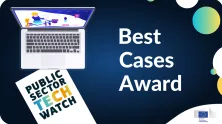Here’s how the Publications Office of the EU is going to streamline the process of classifying public procurement notices with the help of Artificial Intelligence
The Responsible Organisation
The Publications Office of the European Union is the official provider of publishing services to all EU institutions, bodies, and agencies. This makes it the central point of access to EU law, publications, open data, research results, procurement notices, and other official information. Its mission is to operatively support EU policies and make a broad range of information publicly available in the form of accessible and reusable data. The overall aim is to facilitate transparency, economic activity, and the dissemination of knowledge.
The problem
Every year, over 250,000 public authorities in the EU spend around 14% of GDP (around €2 trillion per year) on the purchase of services, works and supplies (European Commission, 2023). TED (Tenders Electronic Daily) is the online version of the ‘Supplement to the Official Journal’ of the EU, dedicated to European public procurement. This online platform is managed by the Publications Office of the EU. Here, 258,000 calls for tenders worth approximately €670 billion are published every year (TED Home Page, 2023).
To ease the process of navigating through the tenders, each notice is categorised according to a Common Procurement Vocabulary (CPV) code, which flags each publication according to the business sector of the tender (e.g., Agriculture and Food, Construction and Real Estate etc.). The CPV codes establish a single classification system for public procurement aimed at standardising the references used by contracting authorities and entities to describe procurement contracts. This process of assigning codes is carried out manually by civil servants of national, regional, or local administrations. For this reason, clerical errors occur and hamper the completion process, making the data less reliable and accurate.
The solution and its implementation
The Publications Office is developing this AI solution to support the administrative process behind the classification of European call for tenders according to the CPV classification. This solution will be based on Natural Language Processing (NLP) and deep learning models and will be able to analyse and classify call for tenders’ texts. This could also be applied to improve, more broadly, TED data quality.
More specifically, the solution will firstly elaborate and suggest to the civil servants responsible for filling in Tenders’ references the best fitting CPV codes. Secondly, the solution could also help in the automatic identification and validation of the budgetary value in the procurement documentation, which is mostly susceptible to clerical errors.
Accordingly, this project can help fulfil a wide range of objectives:
-
With improved data quality, the solution might facilitate the standardisation and accuracy of descriptive statistics (e.g., reporting which contractor got awarded the most contracts from a certain contracting authority).
-
Moreover, better statistics may help predict which companies would be more likely to be awarded with a contract in the future if a tender has certain characteristics (e.g., based on a possible call value or market sector of the call), assisting both administrations and businesses.
Expected benefits
An AI-solution of this kind is expected to bring the following benefits:
-
Data standardisation for better interoperability. The algorithm can guarantee standardisation of data that is necessary to conduct reliable analyses on several elements: finances, types of procurements etc.
-
Improvement of transparency in the public procurement data. The algorithm will immediately flag error or bias in the data, decreasing the chances of clerical errors.
-
Scalability and adaptability of the solution. The algorithm can potentially be reused by all administrations to validate data and immediately get a warning in case of errors or biases.
-
Facilitate the work for businesses. The companies can search using specific codes that are relevant to their activities.
-
Facilitate the process of procurement noticing for administrations. Similarly, public administrations that want to launch a new tender can automatically generate a tender notice, a summary, and a classification in an assisted and simplified way.
-
Decrease in the routine work for clerks, who can focus on other activities within the administrations.
Current challenges
This project is currently facing some challenges:
-
Organisational obstacles. A certain difficulty of contacting the stakeholders (public administrations) in charge of noticing tenders has been reported. Liaising with administrations is desirable to implement this solution smoothly.
-
Lack of specialised skills among clerks. Public administrations may find it difficult to implement this change within their offices because of the lack of competencies of their internal staff. This would eventually require training sessions for clerks to understand how the solution works.
-
Budgetary constraints. There is a high risk that extra-costs will arise, given to the difficulty to forecast the budget needed for future phases (e.g., maintenance of the solution), and that this will hamper the development of the solution.
Useful Link
Detailed Information
Year: 2022
Status: Proof of Concept – In development
Responsible Organization: Publications Office of the European Union
Geographical Extent: National
Countries: European Union
Function of Government: General Public Services
Technology: Artificial Intelligence
AI domain: Natural Language Processing – Machine Learning
Interaction: Government 2 Government and Government 2 Business
Want to know more about this story?









